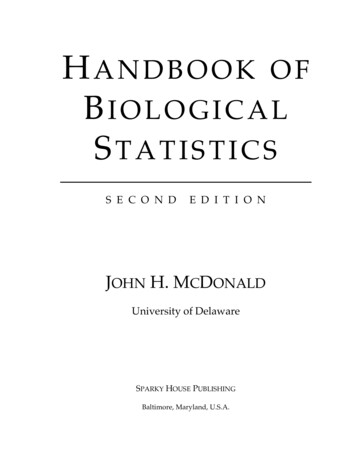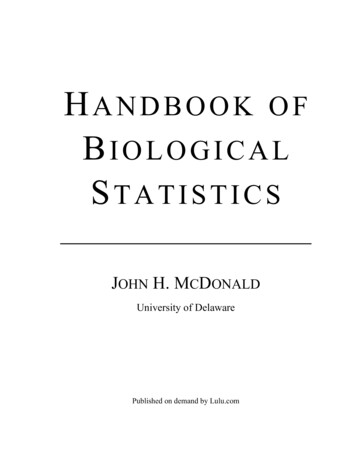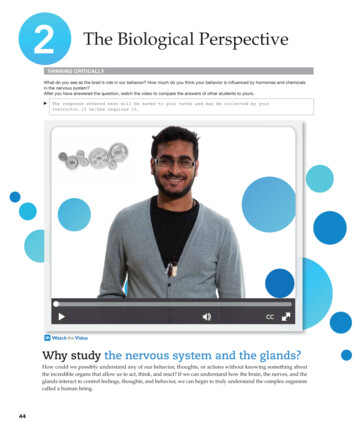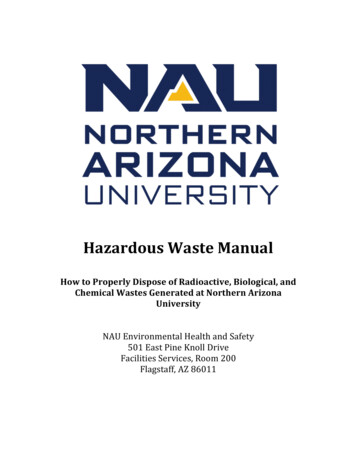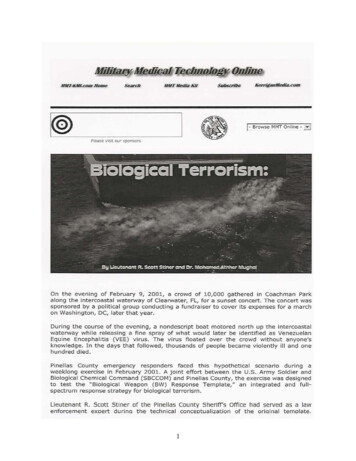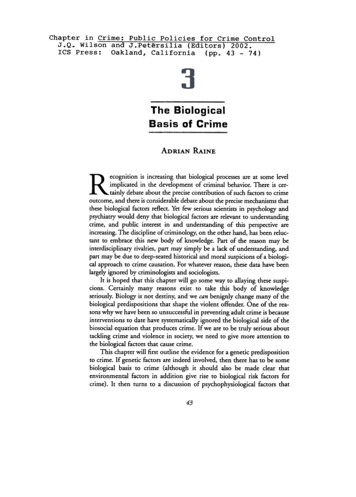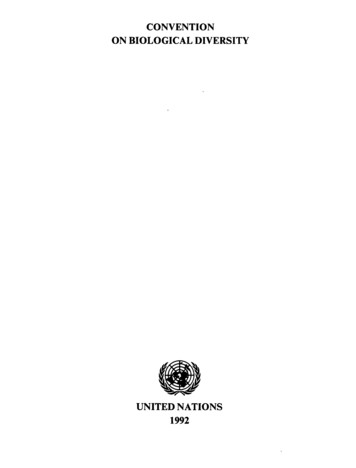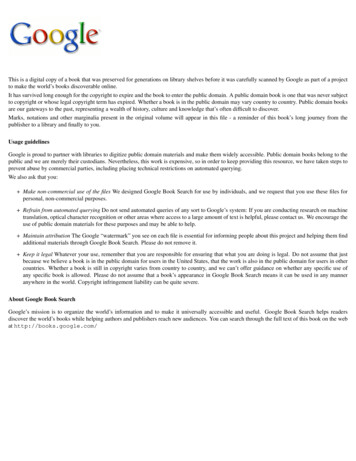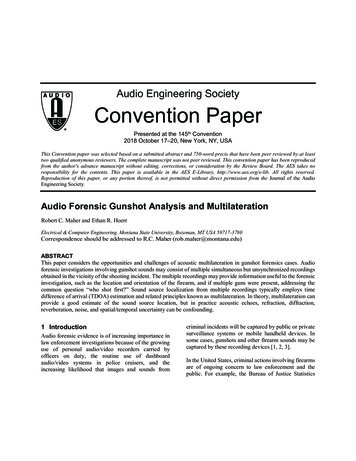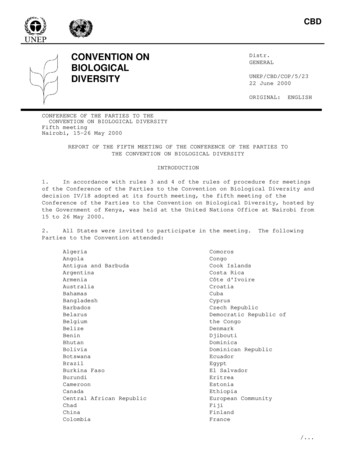
Transcription
CBDCONVENTION 322 June 2000ORIGINAL:ENGLISHCONFERENCE OF THE PARTIES TO THECONVENTION ON BIOLOGICAL DIVERSITYFifth meetingNairobi, 15-26 May 2000REPORT OF THE FIFTH MEETING OF THE CONFERENCE OF THE PARTIES TOTHE CONVENTION ON BIOLOGICAL DIVERSITYINTRODUCTION1.In accordance with rules 3 and 4 of the rules of procedure for meetingsof the Conference of the Parties to the Convention on Biological Diversity anddecision IV/18 adopted at its fourth meeting, the fifth meeting of theConference of the Parties to the Convention on Biological Diversity, hosted bythe Government of Kenya, was held at the United Nations Office at Nairobi from15 to 26 May 2000.2.All States were invited to participate in the meeting.Parties to the Convention attended:AlgeriaAngolaAntigua and anaBrazilBurkina FasoBurundiCameroonCanadaCentral African RepublicChadChinaColombiaThe followingComorosCongoCook IslandsCosta RicaCôte d'IvoireCroatiaCubaCyprusCzech RepublicDemocratic Republic ofthe CongoDenmarkDjiboutiDominicaDominican RepublicEcuadorEgyptEl SalvadorEritreaEstoniaEthiopiaEuropean CommunityFijiFinlandFrance/.
UNEP/CBD/COP/5/23Page aitiHondurasHungaryIcelandIndiaIndonesiaIran (Islamic akhstanKenyaKiribatiKuwaitKyrgyzstanLao People's MadagascarMalawiMalaysiaMaliMarshall ccoMozambiqueMyanmarNamibiaNepalNetherlandsNew maPapua New c of KoreaRepublic of MoldovaRomaniaRussian FederationRwandaSaint Kitts and NevisSaint omon IslandsSouth AfricaSpainSri stanThe former YugoslavRepublic of MacedoniaTogoTongaTrinidad and TobagoTunisiaTurkeyTurkmenistanUgandaUnited Kingdom of GreatBritain and NorthernIrelandUnited Republic ofTanzaniaUruguayVanuatuVenezuelaViet NamZambiaZimbabwe/.
UNEP/CBD/COP/5/23Page 33.The following States were represented by observers:Holy SeeLiberiaLibyan Arab JamahiriyaSaudi ArabiaThailandUnited States of America4.Observers from the following United Nations bodies, Secretariat units,specialized agencies and convention secretariats also attended:Economic Commission for AfricaFood and AgricultureOrganization of the UnitedNations (FAO)Global Environment Facility(GEF)International FinanceCorporation (IFC)Secretariat of the BarcelonaConvention for the Protectionof the Mediterranean Seaagainst PollutionSecretariat of the Conventionon the Conservation ofMigratory Species of WildAnimals(CMS)Secretariat of the RamsarConvention on Wetlands ofInternational Importanceespecially as WaterfowlHabitatSecretariat of the UnitedNations Convention to CombatDesertification in CountriesExperiencing Serious Droughtand/or Desertification,Particularly in Africa5.Secretariat of the ViennaConvention for the Protectionof the Ozone Layer and itsMontreal Protocol onSubstances that Deplete theOzone LayerUNDP Office to CombatDesertification and Drought(UNSO)UNEP World ConservationMonitoring CentreUnited Nations Conference onTrade and Development (UNCTAD)United Nations DevelopmentProgramme (UNDP)United Nations Educational.Scientific and CulturalOrganization (UNESCO)United Nations EnvironmentProgramme (UNEP)United Nations SecretariatUnited Nations UniversityWorld Heritage Centre of UNESCOWorld Intellectual PropertyOrganization (WIPO)World MeteorologicalOrganization (WMOThe following other organizations were represented:(a)Intergovernmental organizations:Agence Africaine deBiotechnologieArab Center for the Studies ofArid Zones and Dry Lands(ACSAD)Commonwealth SecretariatCouncil of EuropeEconomic Community of WestAfrican States (ECOWAS)Energy and EnvironmentalInstitute of FrancophoneCountries (IEPF)International Plant GeneticResources Institute (IPGRI)Organisation for Economic Cooperation and Development(OECD)Programme of Environment forthe Red Sea and the Gulf ofAden (PERSGA)Scientific and TechnicalResearch Commission of theOrganization of African Unity(OAU/STRC)South Pacific RegionalEnvironment Programme (SPREP)Southern African DevelopmentCommunity Plant GeneticResources Centre/.
UNEP/CBD/COP/5/23Page 4(b)Non-governmental organizations:Aboriginal and Torres StraitIslander CommissionAction Aid KenyaAd-hoc Working Group-Tourismof the German NGO ForumAfrica Resources TrustAfrican Biodiversity InstituteAfrican Centre for TechnologyStudies (ACTS)African Conservation CentreAfrican Indigenous WomenOrganization (AIWO)African Wildlife FoundationAgricultural DevelopmentCorporationAgricultural University ofNorwayAkin, Gump, Strauss, Hauer &FeldAlbertine Rift ConservationSociety (ARCOS)Alliance for Youth for HabitatAlliance International desPeuples Indigènes et Tribauxdes Forêts TropicaleAmigransaArab Urban DevelopmentInstituteArid Lands Information NetworkAsociacion ANDESAsociacion Ixacavaa deDesarollo e InformaciónIndigenaAssociacion NapguanaAssociation Burundaise desOiseaux (ABO)Association of TanimbarIntellectuals (ICTI)Association pour la promotiondes batwaBaha'i International CommunityBiodiversity in DevelopmentProject BDPBioNET-INTERNATIONALBioresources development &Conservation ProgramBiotechnology IndustryOrganizationBirdlife InternationalBotanic Gardens ConservationInternational (BGCI)BP AmocoCAB InternationalCentre for Environment andRenewable EnergyCentre for Environment,Technology & Development(CETDEM)Centre for IndigenousKnowledge Systems and ByProducts (CIKSAP)Cohort for Research onEnvironment, UrbanManagement and HumanSettlement (CREUMHS)College of IndigenousAustralian PeoplesConsejo de Todal las TierrasConservation InternationalConserve Africa GroupInternationalConsultative Group onInternational AgriculturalResearch (CGIAR)Cooperativa TechnicoScientifica di Base (COBASE)Coordinación Mapuche deNeuquenCoordinating Body for theIndigenous Peoples'Organizations of the AmazonBasin (COICA)Coordination Nationale pour laDéfense des SemencesFermières (CNDSF)Council for ResponsibleGeneticsCultural and BiologicalDiversityDandora Girls & WomenEducation Centre (DAGWED)Defenders of WildlifeDevelopment and EnvironmentalResearch Agency (DERAA)Diverse Women for DiversityEarthCare AfricaEast Africa EnvironmentalNetworkEast African Wildlife SocietyÉcole Nationale SupérieureAgronomiqueEcooperationECOROPAEcoTerra InternationalEmanzi Food and PeaceDevelopment Centre/.
UNEP/CBD/COP/5/23Page 5Environment 2000Environment Liaison CentreInternational (ELCI)Ethnic Minority and IndigenousRights Organisarion ofAfrica (EMIROAF)EUROPABIO (EuropeanAssociation forBioindustries)European Centre for NatureConservationFauna and Flora InternationalFederation of SaskatchewanIndian NationsFellowship Africa KambeFirst Peoples WorldwideFONA/EANHSForest Action NetworkForest Peoples ProgrammeForum Environment andDevelopment, Working Groupon Biological DiversityFoundation for InternationalEnvironmental Law andDevelopment (FIELD)Franciscans InternationalECOSOCFriends of Nairobi NationalPark (FONNAP)Friends of the Earth/NationalCommittee for the Defence ofthe Fauna and Flora (CODEFF)Fundación Zio-AiGenetic Engineering NetworkGerster DevelopmentConsultantsGhana Wildlife SocietyGIFTSGita PertiwiGlobal Biodiversity Institute,Inc.Global Nature FundGlobal VillageGlobe Southern AfricaGreen Belt MovementGreenpeace InternationalGreenpeace InternationalGuinee EcologieHeifer Project InternationalICFTInternational Institute forEnvironment and Development(IIED)Imperial College, Universityof LondonIndigenous Knowledge ProgrammeIndigenous BiodiversityInformation Network (IBIN)Indigenous Peoples'Secretariat (Canada) on theConvention on BiologicalDiversityInstitute of DevelopmentStudiesInstitute of GeneticEngineeringIntermediate TechnologyDevelopment GroupInternational Centre forResearch in Agroforestry(ICRAF)International Centre for Tradeand Sustainable Development(ICTSD)International Centre of InsectPhysiology and Ecology(ICIPE)International Council of WomenInternational DevelopmentResearch Institute (IDRC)International EnvironmentalAction NetworkInternational Seed TradeFederation/InternationalAssociation of PlantBreeders for the Protectionof Plant Varieties(FIS/ASSINSEL)International Indian TreatyCouncilInternational Ocean InstituteInternational PetroleumIndustry EnvironmentalConservation AssociationInternational Support Groupfor Sustainable TourismInternational Service for theAcquisition of Agri-biotechApplications (ISAAA), AfriCenterKajiado Integrated RuralAssociation for Development(KIRAD)KALPAVRIKSHKenya Association of SocialWorkersKenya Forestry ResearchInstitute (KERI)Kenya School of ProfessionalStudiesKenya Wildlife ServiceKenya Youth Foundation/.
UNEP/CBD/COP/5/23Page 6Kenyatta UniversityLake Victoria EnvironmentManagement ProjectLas Cuatro Flechas de MexicoA.C./Rethinking TourismProjectLaurier Linguistic ServicesLegworks Environment Inc.LUCIDLumatete Muchai & Co.AssociatesMaarifa Women Jua KaliOrganisationMaasai Environmental ResourceCoalitionMakerere UniversityMARECIK-TZMATCOS/Trickle UpDocumentation Centre-NYAMIRAMathare Valley Women Craftsand ShelterMax-Planck InstituteMazingira InstituteMeghalaya Environment andWildlife SocietyMERCMillennium AssessmentSecretariatMonsanto Co./CGCMovimiento AutoridadesIndigenas de ColombiaMovimiento Indigena ColombianoNAADUTARONairobi UniversityNational Landowners WildlifeForumNATURAMA/BirdlifeInternationalNature Conservation Agenda forAfricaNature KenyaNetherlands Center forIndigenous People (NCIV)Nigerian ConservationFoundationNkusi/COBASEOrganizacion Jabiru-YapacanaOrnamental Aquatic TradeAssociationOxford Centre for theEnvironment, Ethics &SocietyPelum AssociationPRONATURA A.C.Pulsar International SwedishSociety for NatureConservationQuaker Peace & ServiceRethinking Tourism ProjectRice UniversityRitamRosterman Environmental YouthRoyal Botanic Gardens, KewRoyal Holloway Institute forEnvironmental ResearchRural Advancement FoundationInternational (RAFI)Russian Association ofIndigenous Peoples of theNorth (RAIPON)Sustainable AgricultureCommunity DevelopmentProgramme (SACDEP) - KenyaSafari Club InternationalFoundationSandama Women EmpowerementUnion S.W., EUSave Environment StudentsAssociationShelter 2000Shelter and SustainableWomen's Aspiration andInitiatives (SSWAAI)Simba Maasai OutreachOrganisation (SIMDO)SobrevivenciaSociety for the Improvement ofRural PeopleSolagral MontpellierSolagral NogentSouth East Asia RegionalInstitute for CommunityEducation (SEARICE)Sunshine Project – US ProgramOfficeSociety for Wildlife andNature International (SWAN)Tana GEF ProjectTe Iwi Moriori Trust BoardTEANThe Edmonds InstituteThe Eye OpenerThe Journal of Food Technologyin Africa (JFTA)The World Conservation Union(IUCN)Traditional and Modern HealthPractitioners TogetherAgainst AIDS (THETA)Third World Network/.
UNEP/CBD/COP/5/23Page 7Torito PlantsTraditional Indigenous HealersTRAFFIC InternationalTropical Institute ofCommunity Health andDevelopment (TICH)Tuskegee UniversityUganda National Council forScience and Technology(UNCST)Uganda Wildlife SocietyUmoja Waso Women GroupUniversité du Québec àMontréal, Observatoire del'ÉcopolitiqueInternationaleUniversity of California,BerkeleyUniversity of FrankfurtUniversity of GeorgiaUniversity of Kent EnglandUniversity of NairobiUniversity of OuagadougouUniversity of OxfordUniversity of TorontoUniversity of TuebingenWATU Accion IndigenaWetlands InternationalWildlife Clubs of KenyaWildlife Conservation SocietyWorld Association of GirlGuides and Girl ScoutsWorld Commission on DamsWorld Endangered SpeciesProtection Association(WESPA)World Resources Institute(WRI)World Wide Fund for Nature(WWF)Youth for Action/.
UNEP/CBD/COP/5/23Page 8I.ORGANIZATIONAL MATTERSAGENDA ITEM 1.1.1.OPENING OF THE MEETINGOpening of the meeting by the President of the fourth meetingof the Conference of the Parties6.The meeting was opened at 10.10 a.m. on Monday, 15 May 2000 byMr. László Miklós, Minister of the Environment of the Slovak Republic andPresident of the fourth meeting of the Conference of the Parties. In hisopening address, Mr. Miklós said that much had been achieved within theConvention process since the fourth meeting of the Conference of the Parties,with the obvious highlight being the successful negotiation of the CartagenaProtocol on Biosafety. Kenya’s hosting of the current meeting was a realdemonstration of that country’s commitment to the issue, entailing a majorsacrifice on the part of a country from a region with legitimate claims ofscarcity of resources. The heavy agenda before the meeting placed a premiumon preparation, and the current meeting was the best prepared yet. Most ofthe items scheduled for discussion were already the subject of carefullycrafted recommendations. Such comprehensiveness was the result of the hardwork carried out during the inter-sessional period not only by the subsidiarybodies of the Convention but also by the Secretariat; he also wished toexpress thanks for the diligence of his fellow members of the Bureau. Inaddition, he wished to pay special tribute to the extraordinary personalefforts of Mr. Juan Mayr Maldonado in bringing to a successful conclusion thenegotiations on the Cartagena Protocol on Biosafety.1.2.Opening statement by Mr. Hamdallah Zedan, Executive Secretaryof the Convention on Biological Diversity7.Addressing the Conference of the Parties at the opening session,Mr. Hamdallah Zedan, Executive Secretary of the Convention, thanked theGovernment of Kenya and its people for hosting the meeting, the ExecutiveDirector of the UNEP for his support, and all those countries that hadsupported Convention activities since the fourth meeting of the Conference ofthe Parties. He thanked specially the Presidents, bureau members and chairsof the Conference of the Parties and its subsidiary bodies and working groups,as well as Canada, host of the Secretariat.8.The period since the fourth meeting of the Conference of the Parties hadbeen a productive one. A number of important meetings had made significantcontributions to advancing the implementation of the Convention, movingtowards agreement on key concepts and mapping out directions for futureactions. The outstanding achievement had been the adoption of the CartagenaProtocol on Biosafety. The participants would consider the work programme ofthe Intergovernmental Committee for the Cartagena Protocol (ICCP) along withother inter-sessional activities and draft decisions contained in documentUNEP/CBD/COP/5/1/Add.2. Mr. Zedan then briefly reviewed the main items beforethe current meeting, drawing particular attention to the three items for indepth discussion - the biological diversity of dry and sub-humid lands,sustainable use, and the question of access to genetic resources - theproposed programme of work on Article 8(j) and related provisions, the variousthematic and cross-cutting issues, as well as important proposals related tothe operations of the Convention. Noting that the development of theproposals had been greatly helped by discussion among the Convention’spartners, he said that that such cooperation was essential to the success of/.
UNEP/CBD/COP/5/23Page 9the Convention. Finally, he said that support, input and guidance at thecurrent meeting regarding the participation of the Convention in thepreparation of the Rio 10 review would be greatly appreciated.1.3.Opening address by Mr. Klaus Töpfer, Executive Director ofthe United Nations Environment Programme (UNEP)9.Addressing the Conference of the Parties at the opening session of themeeting, Mr. Klaus Töpfer, Executive Director of UNEP, said a renewed positiveand cooperative approach was essential to the success of the Convention. Hereaffirmed the keen desire of the United Nations to support the Convention,briefly outlining some of its relevant activities. Africa was a reminder ofthe interrelation between biodiversity and poverty and the concomitant urgentneed for a cooperative approach between industrialized countries and thedeveloping world in areas such as debt relief, capacity-building, technologytransfer and the equitable sharing of benefits from biotechnology andbiological resources. An example of such a cooperative approach was thefinalization of the Cartagena Protocol on Biosafety under the Convention. Thespirit of cooperation engendered by the Cartagena process had also pervadedthe recent meeting on indigenous knowledge in Seville, Spain, and the GlobalBiodiversity Forum held in Nairobi prior to the fifth meeting. The dedicationof UNEP to the Convention and related efforts was apparent on many fronts,including through its commitment to the successful execution of the MillenniumAssessment, its active engagement in a GEF-funded biodiversity supportprogramme, and its participation in capacity-building efforts. UNEP was alsoseeking to make a greater contribution to the important issue of agriculturalbiodiversity.1.4.Address by His Excellency President Daniel Toroitich arapMoi, President of the Republic of Kenya10.At the opening session of the meeting, the Conference of the Partiesheard an address by H.E. President Daniel Toroitich arap Moi, President ofKenya. After welcoming the participants, President Moi noted that the foodsecurity of millions of people was based on the activities of small-scaleproducers who had helped to shape, manage and develop agriculturalbiodiversity. He therefore noted with great satisfaction that agriculturalbiodiversity enjoyed a high profile on the agenda. Biodiversity provided thenatural resource base for socio-economic development for the present and forthe future. The world could not afford to lose much more of that socioeconomic base if the battle to combat poverty and ensure a fair quality oflife for all was to be won. For the Convention to play an effective role,there was a need to develop realistic levels of international action andsubstantial flows of aid in the form of investment towards sustainableactivities. In order to address those issues, the Conference of the Partieshad taken bold steps by developing a programme of work that would requirepartnerships with all stakeholders and financial institutions, includingbilateral and multilateral organizations.11.The recently concluded Cartagena Protocol on Biosafety would contributeto ensuring that there was an adequate level of protection in the safetransfer, handling and use of living modified organisms resulting from moderntechnology. Implementation of the Protocol would, however, require sufficientresources to be made available to build and enlarge technological competencesin biotechnology and establish the biosafety clearing-house mechanism toaccess capabilities in risk management and safety assurance. He noted withsatisfaction that those issues would be fully deliberated upon by the/.
UNEP/CBD/COP/5/23Page 10ministerial round table and the high-level segment to be held in the course ofthe meeting. He also expressed the hope that the question of access andbenefit-sharing would be given all the attention it deserved, as it related tointellectual property rights, indigenous knowledge and bioprospecting.1.5.Statements by the representatives of United Nationsorganizations and convention secretariats12.At the 2nd plenary session of the meeting, on 15 May 2000, statementswere also made by the representatives of the following United Nationsorganizations and convention secretariats: Food and Agriculture Organizationof the United Nations (FAO), United Nations Educational, Scientific andCultural Organization (UNESCO), Secretariat of the Ramsar Convention onWetlands of International Importance especially as Waterfowl Habitat, theWorld Intellectual Property Organization (WIPO), and the Convention on theConservation of Migratory Species of Wild Animals (CMS).13.The representative of FAO said that the conservation and sustainable useof biological diversity for food and agriculture were essential to satisfybasic human needs for food and livelihood security and to achieve sustainableagriculture and rural development. The Conference of the Parties had alreadyrecognized the distinctiveness of agricultural biodiversity and the associatedproblems. FAO and its Commission on Genetic Resources for Food andAgriculture were intergovernmental forums where complex issues related toagricultural biodiversity were discussed and international agreements werenegotiated and adopted. The Commission would welcome requests for assistancefrom the Conference of the Parties on any matter related to biologicaldiversity for food and agriculture. Noteworthy features of cooperationbetween FAO and the Secretariat of the Convention included the renewal of theloan of a Programme Officer dealing with agricultural biodiversity and anassessment of activities in that area being carried out jointly at the requestof the Conference of the Parties at its third meeting, as well as the furtherdevelopment of a programme of work on agricultural biodiversity. FAO alsocooperated technically on issues related to the Convention programme of workon forests, marine and coastal ecosystems and dryland and inland waterecosystems, as well as on cross-sectoral issues such as indicators. Morespecifically, FAO would be pleased to assist in efforts under the next phaseof the Convention's work on forest biological diversity, through the FAOGlobal Forest Resources Assessment, as well as with invasive alien species andliving modified organisms. Finally, he reiterated FAO's commitment to workwith its member countries and the Parties to the Convention in the areasfalling within its mandate.14.The representative of UNESCO drew attention to two background papersprepared by his organization. The first (UNEP/CBD/COP/5/INF/5) provided theParties with a response to the invitation to UNESCO issued by the Conferenceof the Parties in decision IV/10 B to consider launching a global educationand public awareness initiative, while the second (UNEP/CBD/COP/5/INF/27)dealt with the way in which the ecosystem approach and the concept ofbiosphere reserves related to each other. There were other themes and issuesunder the Convention that were being implemented and designed at the sametime: through its multidisciplinary approach (science, education, culture andcommunication), giving rise to a range of programmes, UNESCO was able todeliver the kind of inputs that the Parties to the Convention needed. UNESCOwould continue to assist the Executive Secretary of the Convention in hisefforts to ensure a full launch and successful implementation of the Global/.
UNEP/CBD/COP/5/23Page 11Taxonomy Initiative, a process that needed to be accelerated with innovativefunding. UNESCO hoped to develop a project on training and capacity-buildingin taxonomy. UNESCO would also welcome requests for assistance andpartnership in areas in which it was able to make a contribution.15.Mr. Delmar Blasco, Executive Secretary of the Convention on Wetlands ofInternational Importance especially as Waterfowl Habitat, said that he waspleased to report real progress towards creating a true synergy between theConvention on Biological Diversity and the Convention on Wetlands. Followingthe signing of the Memorandum of Understanding between the two conventions in1996, the first joint work plan for 1998-1999 had been completed, and a newdraft work plan for 2000-2001 had been developed in consultation with theSecretariat of the Convention on Biological Diversity and the chairs of SBSTTAand the Scientific and Technical Review Panel of the Convention on Wetlands.SBSTTA had recommended the adoption of the new work plan, and he sincerelyhoped that that recommendation would receive the support of all delegations.He encouraged Parties to add references to the draft joint work plan in theirdecisions related to other areas of work, such as marine and coastal andforest biodiversity, as well as to the cross-cutting theme of alien invasivespecies, since the draft joint work plan covered all those areas. He was alsopleased to note the proposal to adopt a new format for national reports thatwas very similar to that adopted by the Parties to the Convention on Wetlands.The proposed new format should assist with future efforts to harmonizenational reporting.16.The representative of WIPO stated that WIPO's exploratory work programmeon global intellectual property issues had identified four main areas in whichissues arose regarding the direct and indirect relationship betweenintellectual property and biological diversity: intellectual property andaccess to genetic resources and benefit-sharing; intellectual property and theprotection of traditional knowledge, innovations and practices; intellectualproperty and the transfer of, and access to, technology; and intellectualproperty and scientific and technical cooperation. He reported on the outcomeof the activities that WIPO had undertaken during 1998 and 1999 regardingthese four areas, and provided a description of the activities it was planningto undertake in 2000 and 2001. Jointly with UNEP, WIPO had submitted to theConference of the Parties three case-studies on the role of intellectualproperty rights in the sharing of benefits arising from the use of biologicalresources and associated traditional knowledge (UNEP/CBD/COP/5/INF/26). WIPOhad also convened a meeting on intellectual property and genetic resources on17 and 18 April 2000; the Chairman’s conclusions from that meeting would beformally transmitted to the fifth meeting of the Conference of the Parties.Finally, he said that WIPO was willing to collaborate, within the scope of itsmandate and resources, and in keeping with the guidance of its member States,with the Convention Secretariat and other related bodies, as appropriate, witha view to assisting in the discharge of decisions of the current meetingrelating to intellectual property.17.The Executive Secretary of the Convention on Migratory Species, Mr.Arnulf Müller-Helmbrecht, said that the Secretariat of that Convention hadalways tried to direct the implementation of the Convention on MigratorySpecies towards complementarity with the aims, purposes and instruments of theConvention on Biological Diversity. Most recently, with strong input andguidance from UNEP and after consultations with UNDP and the World Bank, twomedium-sized projects jointly implemented by CMS and the Convention onBiological Diversity, with input from the Secretariat of the Convention on/.
UNEP/CBD/COP/5/23Page 12Wetlands, had been approved by GEF and represented an excellent example ofsynergy in action. Drawing attention to the study entitled "A guide to thecomplementarities between the Convention on Migratory Species and theConvention on Biological Diversity" (UNEP/CBD/COP/5/INF/28), he urged all thenational delegations and the Convention Secretariat to examine it closely todetermine how potential synergies between the two conventions could beidentified, and how the Conference of the Parties could develop and adoptconclusions for further guidance on the subject, at its current or nextmeeeting. Noting that he would bring the matter to the attention of theparties to the Convention on Migratory Species and its subsidiary bodies, heexpressed the hope that the forthcoming meeting of the parties, scheduled forlate August/mid-September 2002, would take similar decisions on such synergiesbetween the two conventions.18.At the 4th plenary session of the meeting, on 22 May 2000, theConference of the Parties heard statements from Mr. Jorge Illueca, AssistantExecutive Director of UNEP and Head of the Division of EnvironmentalConventions, speaking on behalf of Mr.Willem Wijnstekers, Secretary-General ofthe Convention on International Trade in Endangered Species of Wild Fauna andFlora (CITES); Mr. Roberto Lenton, on behalf of the United Nations DevelopmentProgramme (UNDP); and Mr. Mohamed T. El-Ashry, Chief Executive Officer andChairman of the Global Environment Facility (GEF).19.Mr. Illueca said that it was important for CITES and the Convention onBiological Diversity to enhance cooperation and find joint solutions in commonpolicy areas. He congratulated the Conference of the Parties on thesuccessful conclusion of the Cartagena Protocol on Biosafety and offered the25 years of practical experience of the CITES Secretariat in the control ofcross-border movement of live plants and animals, and the parts andderivatives thereof. The ecosystem approach to biological diversity issueswas challenging and was also a major concern of CITES. He believed that itsimplementation could be greatly enhanced through the activities of theConvention on Biological Diversity. On the question of sustainabledevelopment, which was a controversial subject within CITES, there wasconsiderable scope for the two conventions to clarify the issues at stake in acoherent and consistent manner. He stressed that the aims of the twoConventions were complementary and that a close working relationship betweentheir secretariats and between those responsible for their implementationcould not fail to lead to effective and efficient conservation of nature.20.Mr. Lenton said that UNDP had adopted as its overarching corporate goalthe global target of reducing extreme poverty by half by the year 2015.Sustained poverty reduction could be achieved only if the productive capacityof local and global ecosystems, and the goods and services they provided, werealso sustained. UNDP's comparative advantage would be to provide policyadvice, institutional strengthening and capacity-development services. Inaddition, UNDP would make available studies and operational lessons emergingfrom its work to lend support to the work programme
Conference of the Parties to the Convention on Biological Diversity, hosted by . International Environmental Action Network International Seed Trade Federation/International . (FIS/ASSINSEL) International Indian Treaty Council International Ocean Institute International Petroleum Industry Environmental Conservation Association International .
